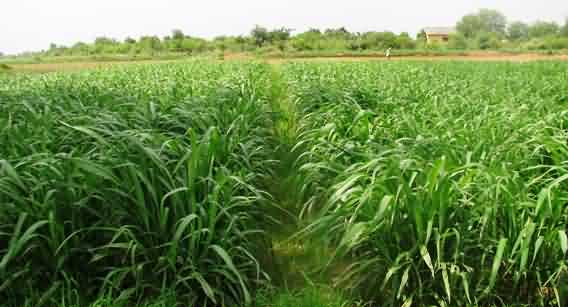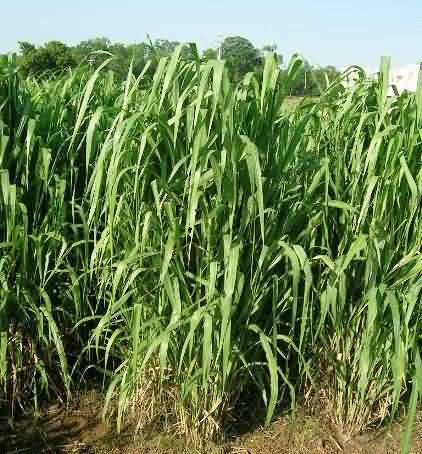बुंदेल गिनी -2: चारा फसल की एक उन्नत किस्म

The forage crops are grown in 4.8 % of the total cultivated land in India to feed 15% of the world’s livestock population. In present situation the country is facing a net deficit of 35.6% green fodder, 10.95% dry fodder and 44% concentrate feed mixture.
Among all fodder grasses, guinea grass is most preferred by farmers for cultivation.
A high yielding and nutritious guinea grass variety BG-2 (JHGG 04-1) was developed through selection. The variety has exhibited average potential to produced 70-90 t/ha green fodder with 7.8 % crude protein content in trials in rainfed condition, however it has potential to yield upto 150 t/ha green fodder under irrigated condition. The variety has shown adaptability to rainfed condition and resistance to drought under semi arid condition.
Guinea grass (Panicum maximum) belongs to the grass family Gramineae/ Poaceae. As a perennial crop, it is suitable for cultivation in humid, tropical and sub tropical areas. It grows well on a wide range of soils and climate.
Guinea grass is also tolerant to the light stress. It has fast growing habit, quick regeneration, good herbage quality and well responsive to fertilizer and irrigation. Being a perennial grass, green fodder yield ranges from 80 to 100 t/ha/year and dry matter productivity 25-35 t/ha.
Due to its multicut nature and high green fodder yield, its adoption is good among farmers both as cultivated crop and pasture crop.
 Bundel Guinea -2
Bundel Guinea -2
The central varietal release committee has released the new variety of Guinea grass in the name of Bundel Guinea-2 (JHGG 04-1). The variety was developed through selection from exotic germplasm EC 400533 (IG 97-3) which was received from ILCA through NBPGR, New Delhi.
The variety is characterized by erect, perennial growth habit, 104 tillers/clump, green stem colour, green foliage, 55 cm long leaf, 1.8 cm broad leaves with 15.8 cm long leaf sheath.
It possess green flowers on long panicle 40-45 cm. Plants are tall 95-155 cm. Its leaf stem ratio was 0.79 and crude protein was found to be 7.8%. The variety flowers once in a year in November.
Cultivation of green fodder crop- Guinea grass
Soil and land preparation
The crop can be grown in almost all kinds of soil with good drainage. Sandy loam to loam soil is most suited. One deep ploughing by disc plough followed by 3-4 harrowing gives desired tilth for transplanting of rooted slips.
Sowing/planting method
The crop is transplanted through seedling or rooted slips. If the grass is transplanted by seedlings, nursery should be raised in the month of May. For 1 ha transplanting 60 sq m nursery area is required.
A nursery bed of 6 m x 1 m size is to be prepared. For each bed 30 kg FYM, 25 g urea and 75 g SSP should be mixed and 40 g seed of guinea grass should be sown in each bed in 10 cm apart lines at the depth of 1 cm.
The beds should be irrigated with help of sprinkler and covered for 4-5 days with the gunny bags or palm leaves. Within 4 to 6 weeks the seedlings attain height of 15-20 cm and thus are ready for transplanting.
For direct sowing in the field, 4-5 kg/ha seed is required. However, raising crop through direct sowing is difficult due to initial dominance of weed. Seeds are of light weight, hence, should be mixed with dry soils for sowing.
Transplanting of seedling/rooted slips can be done immediately with onset of monsoon in 50 cm apart rows and plant to plant distance should be 50 cm. Thus, about 40,000 rooted slips are required for one ha.
Manures and Fertilizers
Guinea grass is a heavy feeder of nutrients and responds well to manures and fertilizers. For better crop growth 20-25 t/ha FYM before 10-15 days of sowing, and at the time of sowing 50 kg N and P2O5, 40 kg K2O, and after each cut 50 kg N/ha should be applied.
Irrigation
First irrigation provided just after sowing or transplanting. Subsequent irrigation 25-30 day’s interval depending upon soil type and weather parameters.
Weed Management
Hand weeding should be done whenever necessary in establishment year only. Generally weeding is not required as a crop attains quick growth and having smothering effect.
Harvesting /Cutting
The first cutting is taken 70-75 days after planting and subsequent cuts are made at interval of 40-45 days. 7-8 cuttings can be obtained annually.
Yield
The average green fodder yield from 3-4 cut under rainfed condition ranges 70-90 t/ha/year, whereas under irrigated condition in 7-8 cuts it can yield upto 150 t/ha/year.
Guinea Grass Based Cropping Systems
To get round the year fodder yield the following guinea grass based cropping systems are also recommended:
- Western and central zone: Guinea grass + Cowpea (summer) and Berseem in winter
- Southern zone: Guinea grass + Cowpea (summer) and Lucerne in winter
Conclusion
The livestock population is increasing rapidly and the pressure to fed the increasing livestock population is also increasing tremendously. To meet the growing demands of green fodder is possible through introduction of high yielding Guinea grass variety viz., Bundel Guinea 2, having potential to produce nutritious green fodder.
The crop is having adaptability to rainfed condition and resistance to drought under semi-arid condition. As the green fodder yielding capacity of crop is high and it will be profitable for dairy farmers the crop is recommended for all India cultivation.
Table 1. Green fodder and dry matter yield, crude protein percent and crude protein yield of Bundel Guinea 2 variety compared with check varieties (All India trials average conducted for three years from 2004 - 06 )
|
Varieties |
Check variety |
JHGG-04-1 (Bundel Guinea 2) |
|
|
Riversdale |
Makuni |
||
|
Green Fodder Yield (q/ha) |
552.5 |
430.6 |
587.3 |
|
Dry Matter yield (q/ha) |
133.8 |
99.3 |
147.2 |
|
Crude Protein % |
7.6 |
7.9 |
7.8 |
|
Crude Protein Yield (q/ha) |
11.8 |
8.3 |
13.4 |
Authors:
V. K. Wasnik*, D. R. Malaviya, A. Maity, D. Vijayand C.K. Gupta
Seed Technology Division, Indian Grassland & Fodder Research Institute, Jhansi 284003
Email: *
